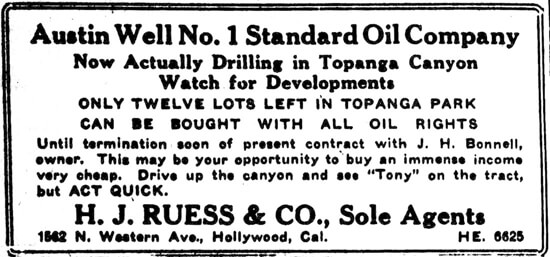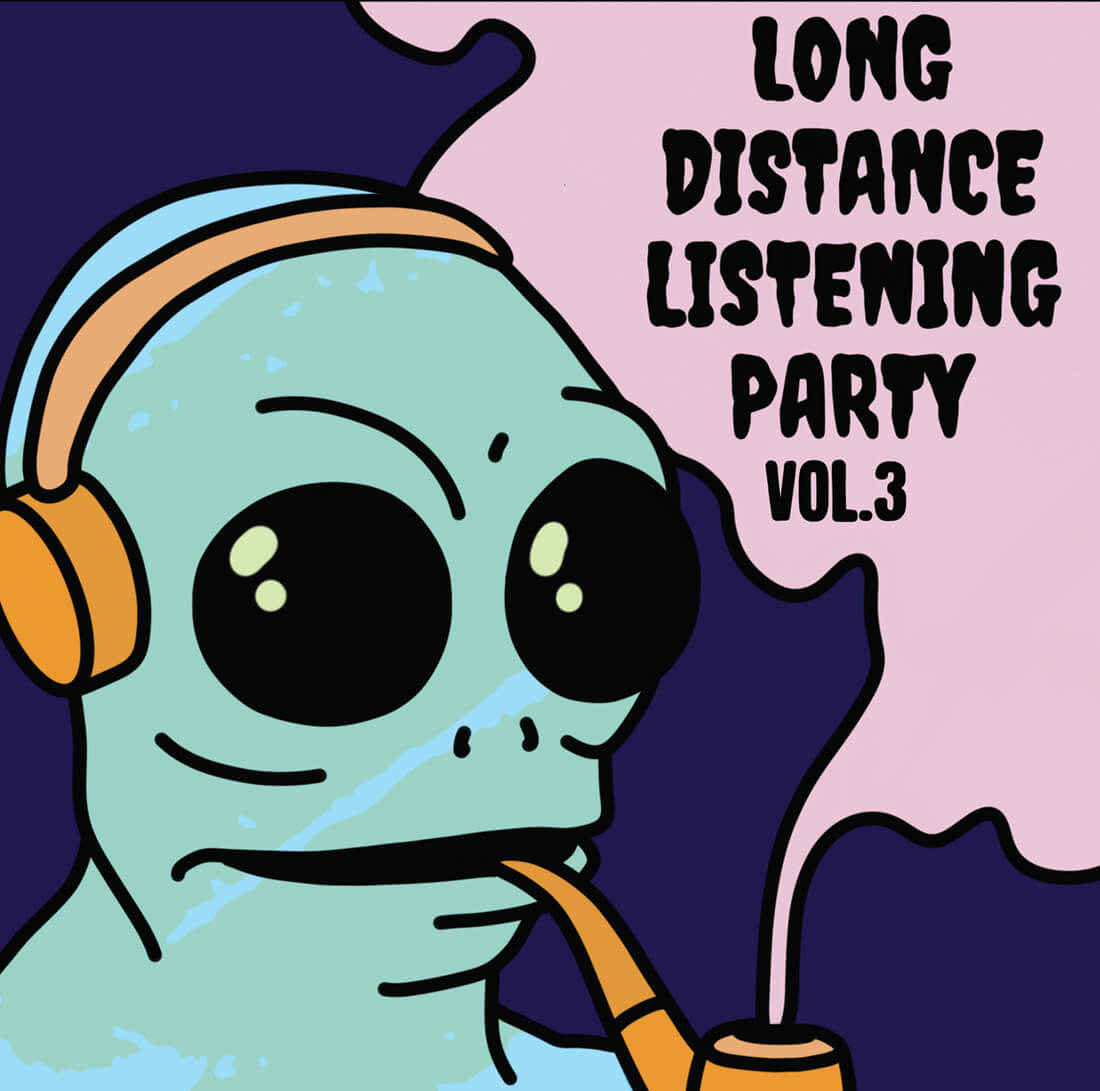The Stone House, Part 3: ‘John Bonnell and the Palmaymesa Family’ | |
The Stone House, Part 3: ‘John Bonnell and the Palmaymesa Family’In 1918, the man who would have the biggest impact on Old Topanga Canyon arrived, John H. Bonnell (1864–1938).
“He was a cultured man and the possessor of moderate wealth. The small valley owned by Jack Woods [sic]... offered such appealing charm that he bought it and many acres of adjacent hill land. He acquired the old apple orchard and the rows of unkept grapes that Mazet had planted many years before. The Mazet home, improved somewhat by Jack Woods, became Bonnell’s new home in his private valley.”
(“Mountain Echoes,” Topanga Journal, 1950-04-14)
Bonnell had made his fortune, first, by following his father into the banking and oil industries in Grand Rapids, Michigan, then, by entering into the lumber business in 1891, after marrying Helen Hackley (b.1863), the niece of a lumber baron. By 1900, he was a widower.
Why he came to Los Angeles with a dream to build “an earthly paradise” “Lots... in Topanga Park can be bought with all oil rights. This may be your opportunity to buy an immense income very cheap.” Ad in the Santa Monica Evening Outlook, 1926-06-02. |
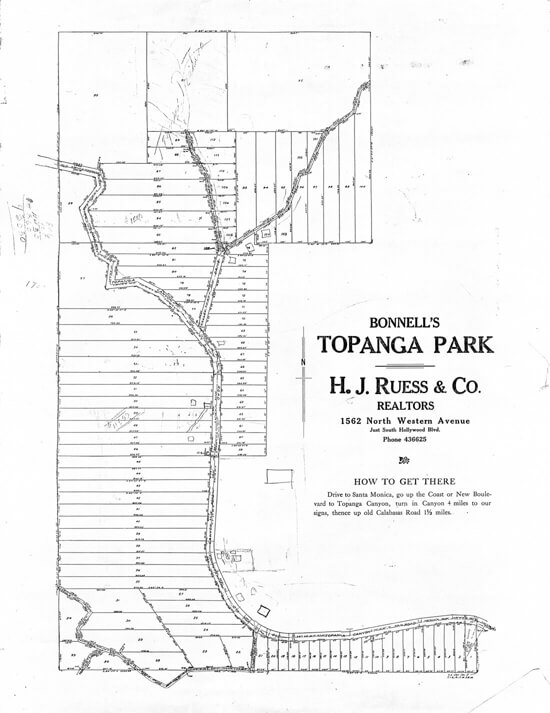 John Bonnell’s Topanga Park. Map c/o the Topanga Historical Society, circa 1926. in the mountains called Topanga Park (later Bonnell Park) is a mystery. It might have had something to do with a woman he was involved with, Claudia, who was 30 years younger. They married in Los Angeles in 1922.
That same year, Vance (1889-1967) and Ruth Hoyt (b.1894) bought the first parcel in Topanga Park. Vance, an osteopath, would go on to write two bestselling novels about the area, Silver Boy: The Gray Fox of Topanga (1929) and Malibu (1933). The latter was made into a film called Sequoia (1934) that was groundbreaking for its use of animal actors.
Dr. Hoyt saw Topanga grow rapidly.
“Right after we had built our cabin in Bonnell’s Topanga Park in 1922, the post war weekenders started to buy into the Canyon. Other real estate tracts were launched in the following order: Fernwood, 1923; Topanga Oaks, 1923; the Post Office Tract, 1924; Calabasas Highland, 1924.
“There were more real estate developments in the Canyon during the twenties than in all the years since.…”
(“Call Back Yesterday,” Topanga Journal, 1961-02-09)  | 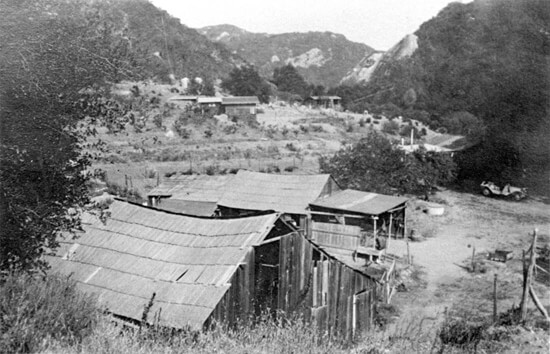 The barn in the foreground is where Rose Wiley’s birthday was celebrated in October. A car is parked, at right, beside the stone house, hidden by a shadow. The Palmaymesa family lived in the house on the hill. Photo c/o Doris Fredendall, the Topanga Historical Society, early 1920s. For other Topanga Park buyers, the incentive was not Bonnell’s “earthly paradise,” but the oil rights that came with the purchase of a cabin. Topanga was predicted to have vast oil deposits at the time. An advertisement urged, “This may be your opportunity to buy an immense income very cheap.”
One barrier to development was Old Topanga Canyon Road, then called Old Calabasas Road, which ran partly in the creek bed and washed out in the rains. Bonnell, together with Red Rock Canyon’s German pioneer Anton “Tony” von Arnswaldt (1878-1948), paid the County to move the road to higher ground. Bonnell further stipulated that the road be moved to the opposite side of the canyon, so that it would no longer pass in front of his house.
Although Bonnell made his presence felt, he didn’t actually live in Topanga, preferring a less rustic lifestyle at the Rex Arms Apartments, one of Los Angeles’s most luxurious residential buildings in downtown. His Topanga ranch was where he kept his four dogs: two big Airedales and two German Shepherds named Victor and Nanette. Nanette was the daughter of Rin Tin Tin (1918-1932), the most famous acting dog in Hollywood. When Bonnell did stay at the stone house, he brought a servant.
The caretakers of Bonnell’s ranch were Bertrand “Bert” (1887-1977) and Mary Palmaymesa (1895-1967). They lived in two small cabins by the creek with their son Floyd (1916-2010), Mary’s teenage cousin Doris Weber (1910-2003), and a hired hand named Juan S. Valdez (b.1879)… whose mother’s name, Maria Tapia, suggests a connection to Malibu’s first settler, José Bartolomé Tapia (c.1766-1824).
Soon, Bonnell built them a new house on the hillside. The Palmaymesas made their home cozy with a piano for Mary, a record player that ran for three minutes when wound up, and a glass-fronted cabinet with a set of Book of Knowledge encyclopedias. Bert dug a cellar beside the house to store food.
Bert’s paternal lineage was Basque, by way of Santa Barbara’s Californios. His father Domingo Palma y Mesa (1857-1893), an earlier  | 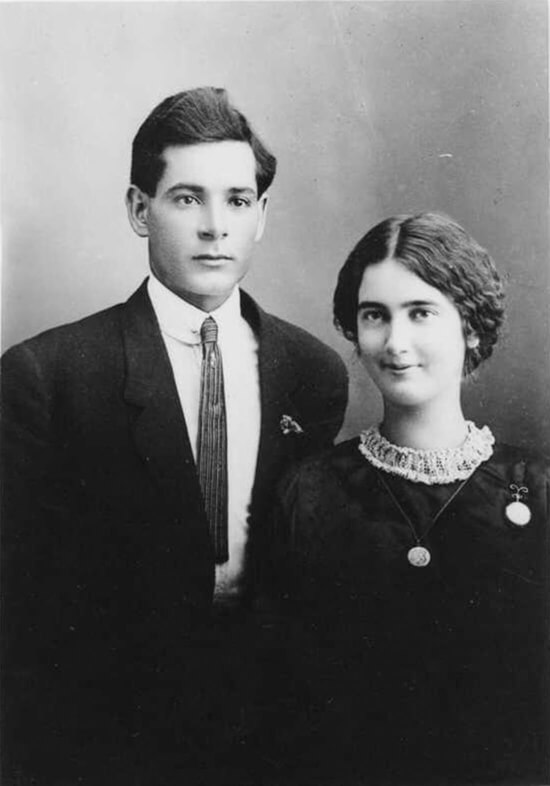 Bert and Mary Palmaymesa. Photo c/o Ancestry.com, circa 1915. spelling of the surname, had homesteaded in Calabasas, where he inevitably clashed with the land-grabbing thug Miguel Leonis. In 1885, Leonis falsely accused Domingo of stealing cattle. Domingo sued and won $500 in damages, with the help of attorney Major Horace Bell (1830-1918), a noted adventurer and historian. Leonis countersued but dropped his case after a year.
Bert’s mother, Maria Camarillo (1832-1973), was a descendant of the family that founded Camarillo. His sister-in-law, Erlinda Pico (1858-1917), was a grandniece of California’s last Mexican governor, Pio Pico (1801-1894).
Mary Palmaymesa had grown up with Bert in Calabasas, and their marriage united a Democrat and a Republican. She sold butter to a Santa Monica bakery. Her cousin, Doris, was an orphan. Doris’s mother, Hattie Weber (1883-1912) had died young, and her father, Joseph Weber (1878-1920) had committed a headline-grabbing suicide by poisoning and stabbing himself. Doris came to Topanga for refuge and healing.
By 1925, Bonnell had given up on his vision of a Utopian community because of a lack of water.
“Two water wells had been drilled over 500 feet deep, but they proved to be meager producers... This was a blow to [John Bonnell] and had a profound bearing upon the life and comfort of all who had bought lots in Topanga Park. His gift of a park and playground to the property owners in Bonnell Flats suffered too, for water was essential in developing it into the kind of a place he dreamed about.”
(“Mountain Echoes,” Topanga Journal, 1950-04-14)
Dr. Hoyt, Bonnell’s first customer, now switched roles and listed Bonnell’s house for sale. As Bonnell backed away from the property, more unscrupulous developers moved in. Their unpermitted dynamite blasting in Dry Canyon started a fire that burned 5,000 acres in 1927.
Dr. Hoyt remembered how precarious things got back then.
“At that time any male with two good legs and arms could be conscripted to fight fires. Oh boy, oh boy! And we had some big fires in those days, with no trucks and no water—only shovels and wet gunny sacks to fight with. Backfiring was our main weapon...
“Sometimes the natives got really rough. There was the ‘eternal triangle’ incident at the Narrows that reached the point of peril. By the time [Constable Al Cheney] got there with his trusty Colt and I arrived with my little black bag, there was no need for either service. The paramour had been blasted in the groin with both barrels of a shotgun and the husband had received a similar charge in the chest.
“On another occasion I was summoned to care for a teenager who had been shot in the neck. In the twenties the open deer season in the Santa Monicas was something to dread by both residents and “sportsmen” alike. The accident occurred at the base of the escarpment of Raven Rocks in Red Rock Canyon.”
(“Call Back Yesterday,” Topanga Journal, 1961-02-09)  | 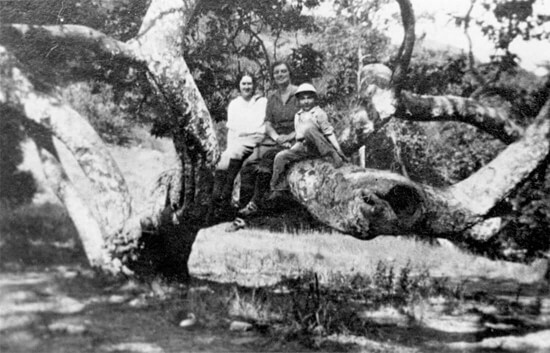 Floyd Palmaymesa with Mary’s sister Hazel and friend Ruth Choisser. Photo c/o Doris Fredendall, the Topanga Historical Society, 1920s. Bonnell’s marriage to Claudia had ended by 1924. Their relationship lasted roughly the same length as his dream for Topanga Park. She complained that he treated her as socially inferior. He accused her of being a gold digger. After returning to Grand Rapids, he died at age 74 of syphilis. His name lives on in Bonnell Park and Bonnell Drive.
On May 6, 1928, another development opened at the fork in the creek, Topanga Del Mar, built by the John A. Vaughan Corporation of Beverly Hills. To help promote it, Bonnell Park was given a new “formal opening” on the same day. Both developments shared the same General Sales Manager, William J. McGhee, formerly an executive of the Walter M. Murphy Motors Company in Pasadena. Yet even though “Artistic Tract Offices,” constructed on both properties, purported to sell “all the exclusiveness and dignity of The Riviera,” the water problem remained unsolved.
Ironically, a “liquidation sale” of Topanga Park (briefly renamed the Topanga Vista Tract) followed in 1931, with developers still promising “an abundance of water,” “water to every lot.”
Next, developers tried dividing Topanga Park into four units.
“The first unit of Bonnell Flats was surveyed in 1933 with the second half following soon after. The hill land was included in units Three and Four.”
(“Mountain Echoes,” Topanga Journal, 1950-04-14)
Today, only “Bonnell Flats” remains in Bonnell Park.
Despite Bonnell’s problems, the Palmaymesas had a good life in Topanga. They left when Mary became pregnant with Patrick Palmaymesa (1927-2017), moving to Owensmouth (now Canoga Park), where Bert got a job in a grocery store. Three more children soon followed: Robert Palmaymesa (1929-2012), Jean Palmaymesa (1931-2013), and Barbara Palmaymesa (1931-2008). In 1941, the family moved to Ripon, CA, where Bert worked for Meyenberg Milk Products.
The Topanga children, Doris and Floyd, both treasured their memories of life in the Canyon.
Doris married Mercer Fredendall (1904-1975), a Pomona rancher, when she turned 18 in 1928. Shortly before her death at 93, she shared many stories and photos with the Stone House’s then-owners, Ingrid Lindquist and Dede Potvin, which offer a vivid glimpse into the Topanga of her youth.
“The turkeys and chickens ran in the high-fenced apple orchard that produced out-sized winter banana apples of nice fragrance. Deer came into the orchard in the early evening, reached up into the apple trees and took their fill. Water for the house came from a well dug at creekside and pumped with a gasoline engine to a tank on the hill above the house.”
(The Topanga Story, 2012)
Floyd grew up to be an outdoorsman. He loved camping, hunting, woodworking, making jewelry from his rock collection, and telling family stories to his grandchildren.
Pablo Capra is the Archivist for the Topanga Historical Society and author of “Topanga Beach: A History” (2020). More at topangahistoricalsociety.org.  | | | | | | | | | | | |
|
|
|
|
|




